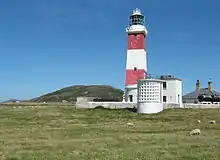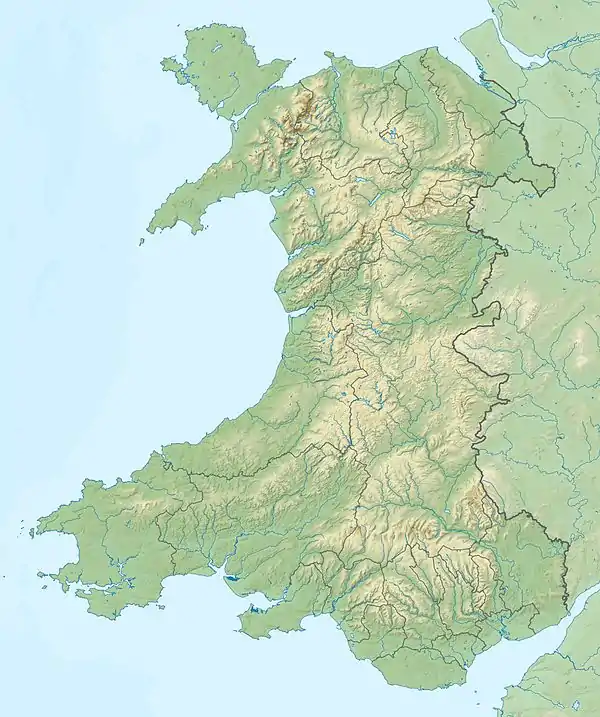Bardsey Lighthouse
Bardsey Lighthouse stands on the southerly tip of Bardsey Island, off the Llŷn Peninsula in Gwynedd, Wales, and guides vessels passing through St George's Channel and the Irish Sea.
 Bardsey Lighthouse in 2008 | |
 Wales | |

| |
| Location | Bardsey Island Gwynedd Wales United Kingdom |
|---|---|
| Coordinates | 52.749925°N 4.799754°W |
| Year first constructed | 1821 |
| Automated | 1987 |
| Construction | masonry tower |
| Tower shape | square tower with balcony and lantern |
| Markings / pattern | white and red horizontal bands tower, white lantern |
| Tower height | 30 metres (98 ft) |
| Focal height | 39 metres (128 ft) |
| Current lens | LED lantern |
| Light source | solar power |
| Intensity | 52,277 candela |
| Range | 18 nautical miles (33 km; 21 mi) |
| Characteristic | Fl R 10s. |
| Admiralty number | A5234 |
| NGA number | 5548 |
| ARLHS number | WAL-001 |
| Managing agent | Bardsey Island Trust[1][2] |
| Heritage | Grade II listed building |
History
Application for a light here was first made in 1816 by Lt. Thomas Evans R.N., but several other applications made in 1820 finally resulted in the building of the tower by Trinity House in 1821 at a cost of £5,470 12s 6d plus a further £2,950 16s 7d for the lantern[3] (equivalent to £400,000 and £200,000 in 2016[4]).
Joseph Nelson was the engineer and builder, but the heavy weathered string-course near the base and the blocked and hooded directional-light window show the influence of Daniel Alexander, who succeeded Samuel Wyatt as consulting engineer[5] to Trinity House, and under whom Nelson served.[3] Joseph Nelson is associated with the design of at least fifteen lighthouses, mostly in the Bristol Channel.[3]
In 1987 the lighthouse was converted to automatic operation and up until 1995 was monitored from the Trinity House area control station at Holyhead. It is now monitored from the Trinity House depot at Harwich,[6] with a local part-time attendant carrying out routine maintenance.[3]
Architecture
The lighthouse is built of ashlar limestone and is unplastered inside and out, but painted in red and white bands on the outside.[3] The lighthouse tower is 30 m (98 ft) high and is unusual amongst Trinity House towers of this period in being square in plan (Coquet Lighthouse, Northumberland is also square). Unlike many other lighthouses, it retains its original gallery railings, which are of iron and bellied (i.e. curved out in width at their crowns) towards the top.[3] Other examples include Salt Island Lighthouse, at Holyhead, designed by John Rennie in the same year. The present lantern, fitted in 1856, did not require the removal of the original railings.[3]
The plinth of the tower is 4 m (13 ft) high and elaborately enriched, and at ground level it forms a square of 7.6 m (25 ft) reducing to 6.1 m (20 ft) at the top of the plinth and 4.6 m (15 ft) at the top of the tower below the crowning cornice, which juts out in a square of 5.5 m (18 ft).[3] The walls are 1.2 m (4 ft) thick at the base reducing to under 0.9 m (3 ft) at the top.[3] Originally, the light comprised reflectors but changed to a dioptric (refracting) mechanism in 1838; the appearance of the original lantern is not known. The present lantern of 1856 is a 4.27 m (14 ft) wide chamfered octagon and the light remained fixed, instead of revolving. The present revolving apparatus was installed in 1873 and gives a group of five flashes, originally driven by a vapourising oil-lamp, but replaced by electric in 1973.[3]
The lighthouse is unusual in lacking any sort of harbour or quay facilities.[3] As it is on an established migratory route, the tower has many bird casualties and The Royal Society for the Protection of Birds and Trinity House have tried to help the problem by providing perches on the lantern top and flood-lighting the tower, although this does not seem to have helped.[3]
See also
References
- Bardsey The Lighthouse Directory. University of North Carolina at Chapel Hill. Retrieved 1 June 2016
- Bardsey Lighthouse Trinity House. Retrieved 1 June 2016
- Douglas Bland Hague, Lighthouses of Wales Their Architecture and Archaeology, 1994, Royal Commission on the Ancient and Historical Monuments of Wales, Aberystwyth, 102 pages, ISBN 1-871184-08-8
- United Kingdom Gross Domestic Product deflator figures follow the Measuring Worth "consistent series" supplied in Thomas, Ryland; Williamson, Samuel H. (2018). "What Was the U.K. GDP Then?". MeasuringWorth. Retrieved 2 February 2020.
- Ken Trethewey. "Daniel Alexander - Pharology". pharology.eu. Archived from the original on 22 March 2016.
- Trinity House : Bardsey Lighthouse Retrieved 16 August 2009
External links
| Wikimedia Commons has media related to Bardsey Lighthouse. |
- "Bardsey Lighthouse". Trinity House.
